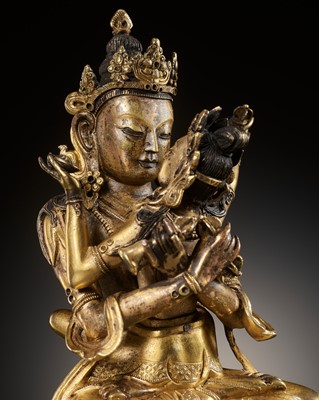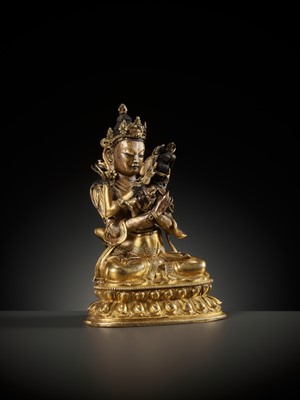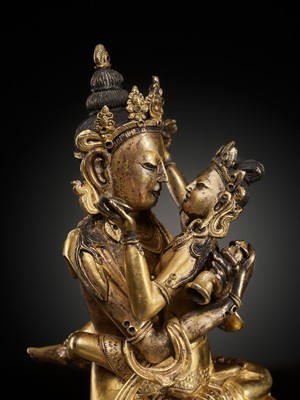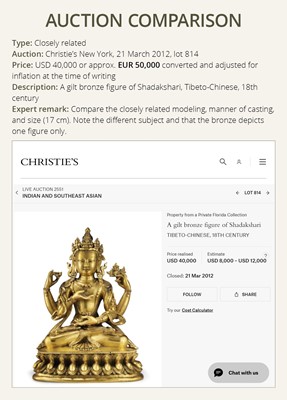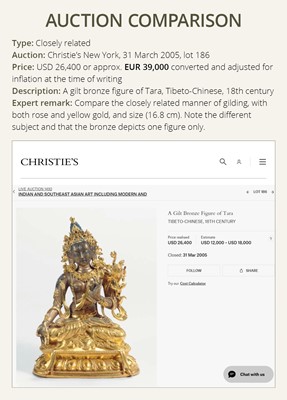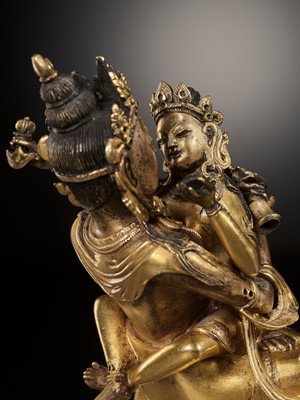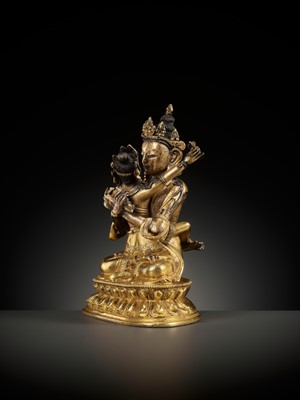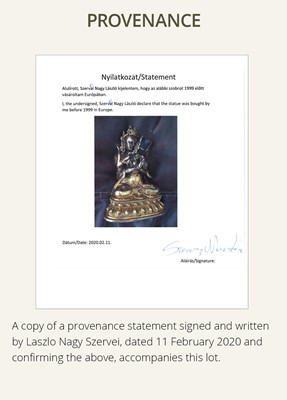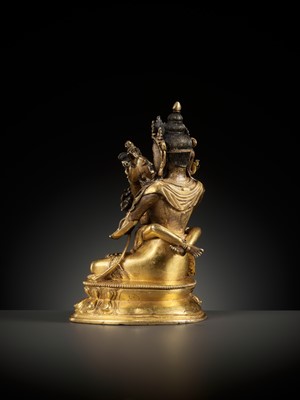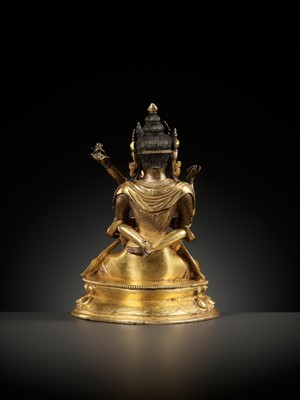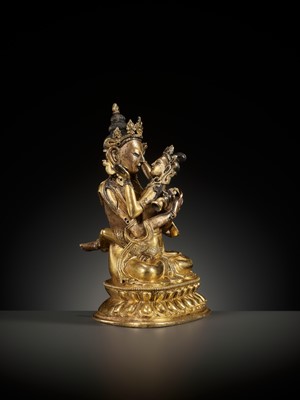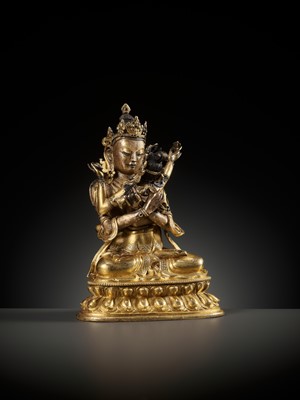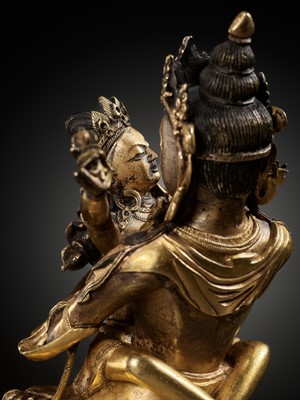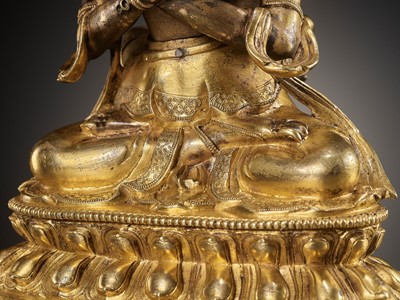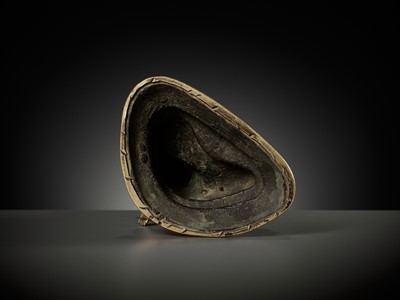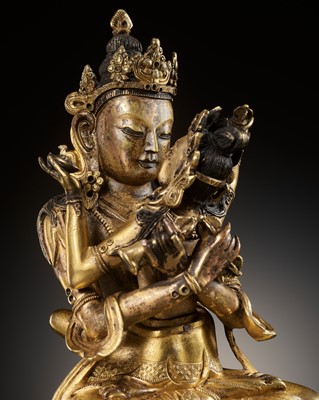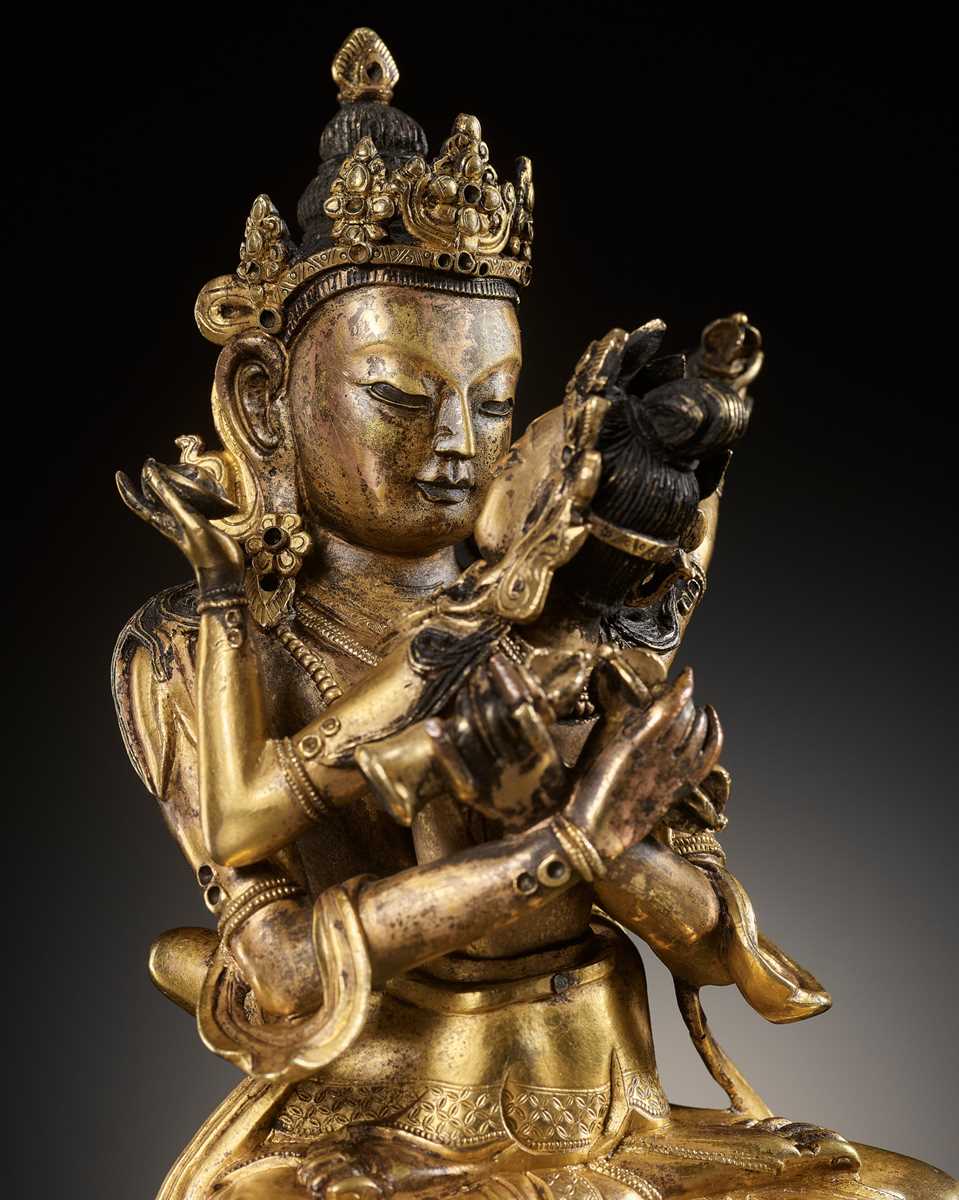11th Apr, 2024 11:00
TWO-DAY AUCTION: Fine Asian Art, Buddhism and Hinduism
56
A RARE TWO-TONE GILT BRONZE FIGURE OF VAJRADHARA AND SAMANTABHADRI IN UNION, 18TH CENTURY
Sold for €33,800
including Buyer's Premium
Expert’s note: This superb bronze is gilt in both yellow and rose gold. The rose gold is visible on the face, arms, and abdomen of Vajradhara and is distinguishable from the yellow gold gilding by its fainter, reddish tone and by its flaking (a natural phenomenon caused by the copper content within the alloy). Yellow gold, visible on the base, legs, and shawl, contains a higher concentration of gold within the alloy, making it more resistant to discoloration from wear.
China. Finely cast, seated in dhyanasana on a double-lotus base with a beaded rim, joined in union (yab yum) to his consort whose legs wrap gently behind, holding a vajra and ghanta in both hands as she holds a kapala and kartika. Wearing a dhoti incised with an elegant pattern along the beaded hem, each adorned with elaborate jewelry and wearing a foliate tiara secured by ribbons. Their serene faces with sinuously lidded eyes and bow-shaped lips, the hair neatly arranged into high chignons falling in strands down the shoulders.
Provenance: From the collection of Laszlo Nagy Szervei, acquired before 1999 in the European trade. Hungarian private collection, acquired from above. A copy of a provenance statement signed and written by Laszlo Nagy Szervei, dated 11 February 2020 and confirming the above, accompanies this lot.
Condition: Very good condition with old wear and casting flaws as expected and commensurate with age, light rubbing to gilt, few small nicks, the inlays lost.
Weight: 1,542 g
Dimensions: Height 17 cm
Yab yum images symbolizing the enlightened integration of wisdom and compassion through the metaphor of 'mother-father' deities in sexual congress are arguably the most enthralling subject in Buddhist art, emblematic of the religion's distinctive character and material culture. Yab yum iconography is frequently deployed to depict yidams, like Guhyasamaja, which are an important class of "meditational deities" in Tantric Buddhism. Other popular yidams include Chakrasamvara, Vajrabhairava, Hevajra, and Kalachakra. These yidams and their retinue within a surrounding mandala are the topic of a class of tantric teachings called the "Unsurpassed Yoga Tantras" (Anuttarayoga Tantra). According to Tibetan exegetes, the practice of Anuttarayoga Tantra is the only means through which the practitioner's ultimate goal of Buddhahood can be achieved; it cannot be achieved through mastering other 'lower tantras' or by the Mahayanist practice of the Bodhisattva Path.
Auction result comparison:
Type: Closely related
Auction: Christie’s New York, 31 March 2005, lot 186
Price: USD 26,400 or approx. EUR 39,000 converted and adjusted for inflation at the time of writing
Description: A gilt bronze figure of Tara, Tibeto-Chinese, 18th century
Expert remark: Compare the closely related manner of gilding, with both rose and yellow gold, and size (16.8 cm). Note the different subject and that the bronze depicts one figure only.
Auction result comparison:
Type: Closely related
Auction: Christie’s New York, 21 March 2012, lot 814
Price: USD 40,000 or approx. EUR 50,000 converted and adjusted for inflation at the time of writing
Description: A gilt bronze figure of Shadakshari, Tibeto-Chinese, 18th century
Expert remark: Compare the closely related modeling, manner of casting, and size (17 cm). Note the different subject and that the bronze depicts one figure only.
Expert’s note: This superb bronze is gilt in both yellow and rose gold. The rose gold is visible on the face, arms, and abdomen of Vajradhara and is distinguishable from the yellow gold gilding by its fainter, reddish tone and by its flaking (a natural phenomenon caused by the copper content within the alloy). Yellow gold, visible on the base, legs, and shawl, contains a higher concentration of gold within the alloy, making it more resistant to discoloration from wear.
China. Finely cast, seated in dhyanasana on a double-lotus base with a beaded rim, joined in union (yab yum) to his consort whose legs wrap gently behind, holding a vajra and ghanta in both hands as she holds a kapala and kartika. Wearing a dhoti incised with an elegant pattern along the beaded hem, each adorned with elaborate jewelry and wearing a foliate tiara secured by ribbons. Their serene faces with sinuously lidded eyes and bow-shaped lips, the hair neatly arranged into high chignons falling in strands down the shoulders.
Provenance: From the collection of Laszlo Nagy Szervei, acquired before 1999 in the European trade. Hungarian private collection, acquired from above. A copy of a provenance statement signed and written by Laszlo Nagy Szervei, dated 11 February 2020 and confirming the above, accompanies this lot.
Condition: Very good condition with old wear and casting flaws as expected and commensurate with age, light rubbing to gilt, few small nicks, the inlays lost.
Weight: 1,542 g
Dimensions: Height 17 cm
Yab yum images symbolizing the enlightened integration of wisdom and compassion through the metaphor of 'mother-father' deities in sexual congress are arguably the most enthralling subject in Buddhist art, emblematic of the religion's distinctive character and material culture. Yab yum iconography is frequently deployed to depict yidams, like Guhyasamaja, which are an important class of "meditational deities" in Tantric Buddhism. Other popular yidams include Chakrasamvara, Vajrabhairava, Hevajra, and Kalachakra. These yidams and their retinue within a surrounding mandala are the topic of a class of tantric teachings called the "Unsurpassed Yoga Tantras" (Anuttarayoga Tantra). According to Tibetan exegetes, the practice of Anuttarayoga Tantra is the only means through which the practitioner's ultimate goal of Buddhahood can be achieved; it cannot be achieved through mastering other 'lower tantras' or by the Mahayanist practice of the Bodhisattva Path.
Auction result comparison:
Type: Closely related
Auction: Christie’s New York, 31 March 2005, lot 186
Price: USD 26,400 or approx. EUR 39,000 converted and adjusted for inflation at the time of writing
Description: A gilt bronze figure of Tara, Tibeto-Chinese, 18th century
Expert remark: Compare the closely related manner of gilding, with both rose and yellow gold, and size (16.8 cm). Note the different subject and that the bronze depicts one figure only.
Auction result comparison:
Type: Closely related
Auction: Christie’s New York, 21 March 2012, lot 814
Price: USD 40,000 or approx. EUR 50,000 converted and adjusted for inflation at the time of writing
Description: A gilt bronze figure of Shadakshari, Tibeto-Chinese, 18th century
Expert remark: Compare the closely related modeling, manner of casting, and size (17 cm). Note the different subject and that the bronze depicts one figure only.
Zacke Live Online Bidding
Our online bidding platform makes it easier than ever to bid in our auctions! When you bid through our website, you can take advantage of our premium buyer's terms without incurring any additional online bidding surcharges.
To bid live online, you'll need to create an online account. Once your account is created and your identity is verified, you can register to bid in an auction up to 12 hours before the auction begins.
Intended Spend and Bid Limits
When you register to bid in an online auction, you will need to share your intended maximum spending budget for the auction. We will then review your intended spend and set a bid limit for you. Once you have pre-registered for a live online auction, you can see your intended spend and bid limit by going to 'Account Settings' and clicking on 'Live Bidding Registrations'.
Your bid limit will be the maximum amount you can bid during the auction. Your bid limit is for the hammer price and is not affected by the buyer’s premium and VAT. For example, if you have a bid limit of €1,000 and place two winning bids for €300 and €200, then you will only be able to bid €500 for the rest of the auction. If you try to place a bid that is higher than €500, you will not be able to do so.
Online Absentee and Telephone Bids
You can now leave absentee and telephone bids on our website!
Absentee Bidding
Once you've created an account and your identity is verified, you can leave your absentee bid directly on the lot page. We will contact you when your bids have been confirmed.
Telephone Bidding
Once you've created an account and your identity is verified, you can leave telephone bids online. We will contact you when your bids have been confirmed.
Classic Absentee and Telephone Bidding Form
You can still submit absentee and telephone bids by email or fax if you prefer. Simply fill out the Absentee Bidding/Telephone bidding form and return it to us by email at office@zacke.at or by fax at +43 (1) 532 04 52 20. You can download the PDF from our Upcoming Auctions page.
How-To Guides
How to Create Your Personal Zacke Account
How to Register to Bid on Zacke Live
How to Leave Absentee Bids Online
How to Leave Telephone Bids Online
中文版本的操作指南
创建新账号
注册Zacke Live在线直播竞拍(免平台费)
缺席投标和电话投标
Third-Party Bidding
We partner with best-in-class third-party partners to make it easy for you to bid online in the channel of your choice. Please note that if you bid with one of our third-party online partners, then there will be a live bidding surcharge on top of your final purchase price. You can find all of our fees here. Here's a full list of our third-party partners:
- 51 Bid Live
- EpaiLive
- ArtFoxLive
- Invaluable
- LiveAuctioneers
- the-saleroom
- lot-tissimo
- Drouot
Please note that we place different auctions on different platforms. For example, in general, we only place Chinese art auctions on 51 Bid Live.
Bidding in Person
You must register to bid in person and will be assigned a paddle at the auction. Please contact us at office@zacke.at or +43 (1) 532 04 52 for the latest local health and safety guidelines.
